Financial Management Plan: NZDB6213 Analysis of Warehouse Ltd
VerifiedAdded on 2022/09/15
|18
|2883
|10
Report
AI Summary
This report provides a comprehensive financial analysis of Warehouse Ltd, examining various aspects of its financial management. It begins with an overview of the company's business details, including its operational sectors and financial goals. The report then delves into agency theory, explaining the relationships between stakeholders and management. Capital budgeting techniques, such as NPV and IRR, are applied to evaluate potential projects. Key performance indicators (KPIs), including profitability and efficiency ratios, are analyzed to assess the company's financial performance over a three-year period. The report also explores financial risk analysis, using standard deviation and coefficient of variation to compare Warehouse Ltd's risk profile to its competitors. Furthermore, it discusses the impact of working in a global context, focusing on currency and country risks, and examines Warehouse Ltd's engagement with both internal and main stakeholders. The report also analyzes the company's compliance with internal and external business requirements, including corporate governance and environmental sustainability initiatives. Finally, it applies business knowledge to analyze financial information and discusses the appropriate behaviors demonstrated by the company.
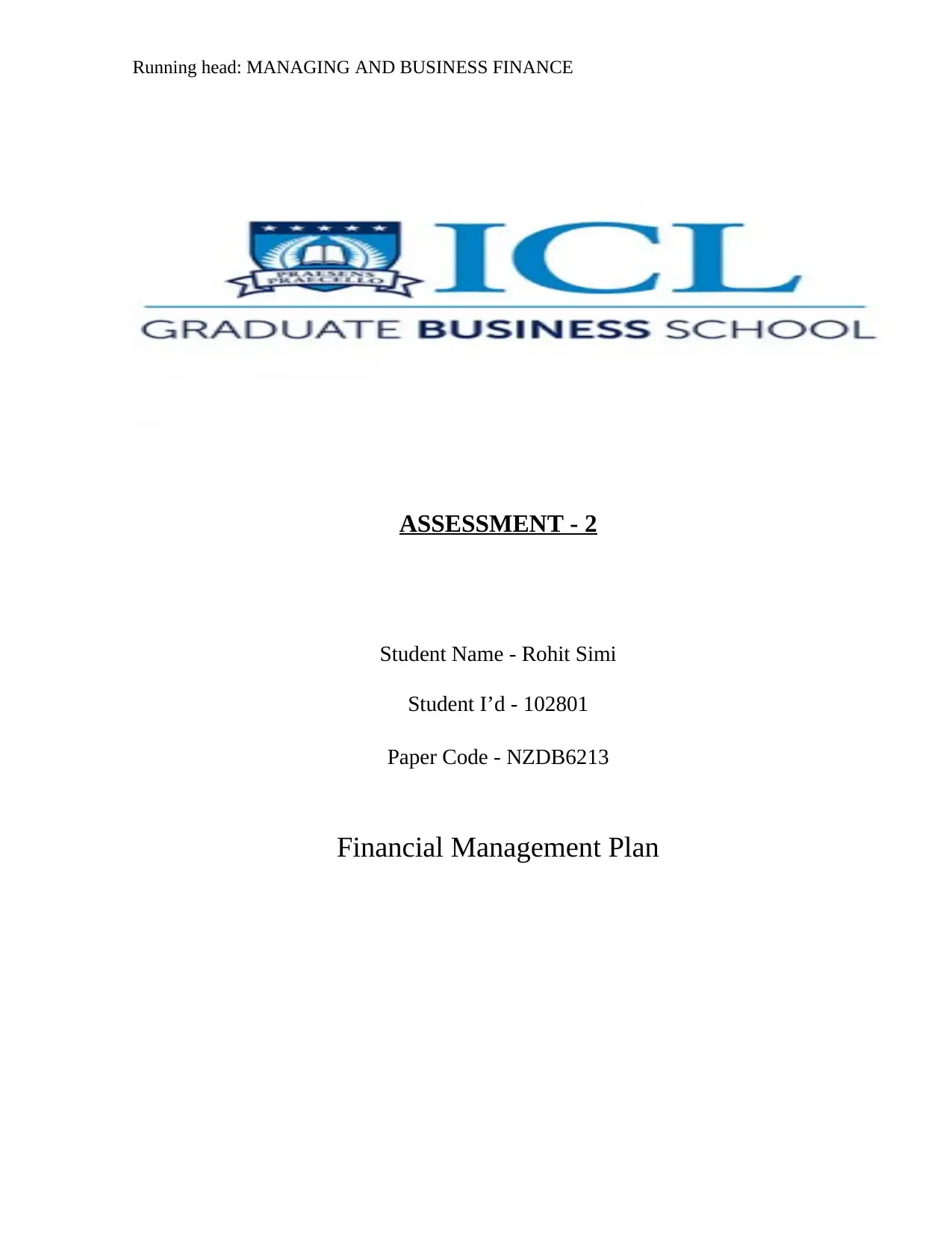
Running head: MANAGING AND BUSINESS FINANCE
ASSESSMENT - 2
Student Name - Rohit Simi
Student I’d - 102801
Paper Code - NZDB6213
Financial Management Plan
ASSESSMENT - 2
Student Name - Rohit Simi
Student I’d - 102801
Paper Code - NZDB6213
Financial Management Plan
Paraphrase This Document
Need a fresh take? Get an instant paraphrase of this document with our AI Paraphraser
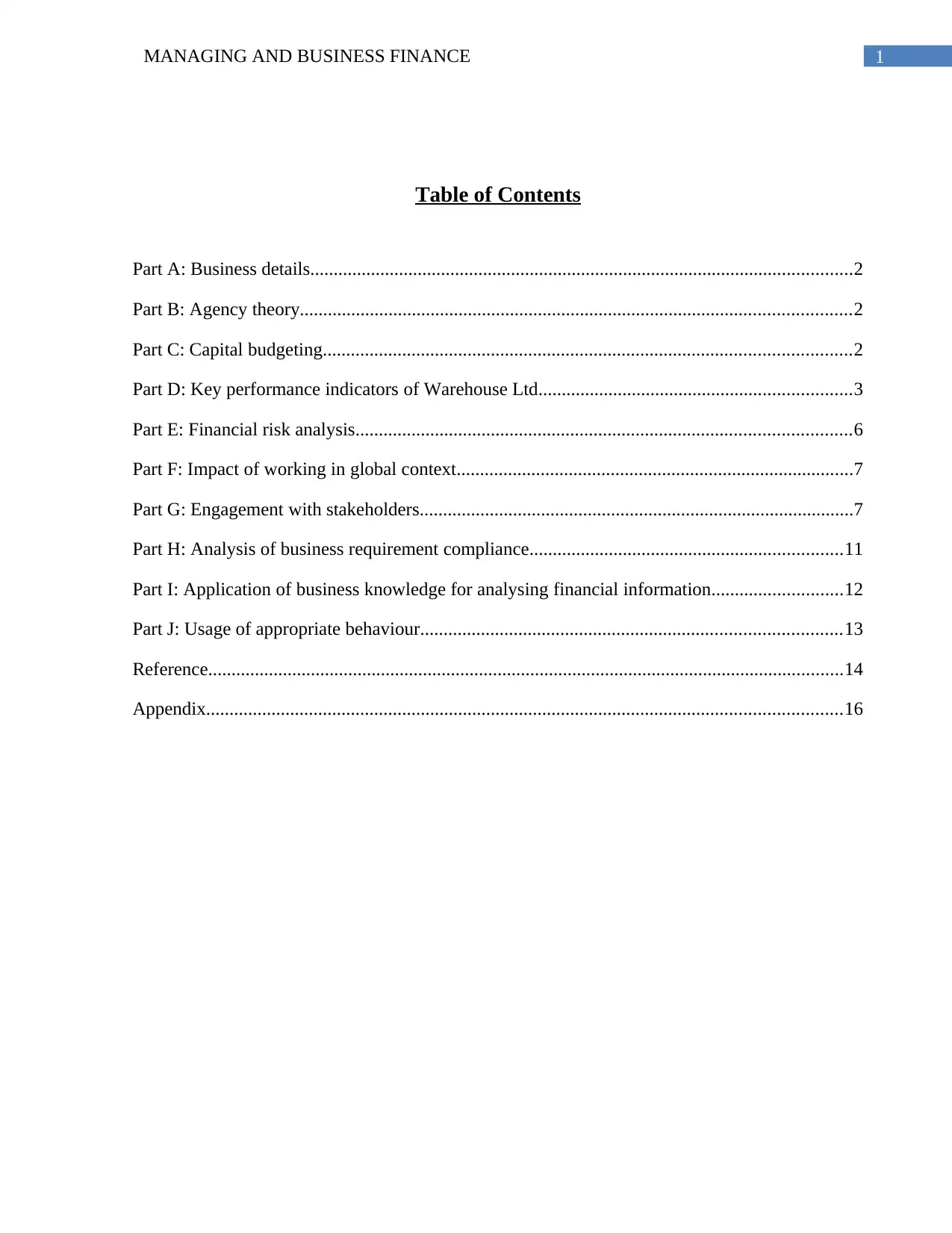
1MANAGING AND BUSINESS FINANCE
Table of Contents
Part A: Business details....................................................................................................................2
Part B: Agency theory......................................................................................................................2
Part C: Capital budgeting.................................................................................................................2
Part D: Key performance indicators of Warehouse Ltd...................................................................3
Part E: Financial risk analysis..........................................................................................................6
Part F: Impact of working in global context.....................................................................................7
Part G: Engagement with stakeholders.............................................................................................7
Part H: Analysis of business requirement compliance...................................................................11
Part I: Application of business knowledge for analysing financial information............................12
Part J: Usage of appropriate behaviour..........................................................................................13
Reference........................................................................................................................................14
Appendix........................................................................................................................................16
Table of Contents
Part A: Business details....................................................................................................................2
Part B: Agency theory......................................................................................................................2
Part C: Capital budgeting.................................................................................................................2
Part D: Key performance indicators of Warehouse Ltd...................................................................3
Part E: Financial risk analysis..........................................................................................................6
Part F: Impact of working in global context.....................................................................................7
Part G: Engagement with stakeholders.............................................................................................7
Part H: Analysis of business requirement compliance...................................................................11
Part I: Application of business knowledge for analysing financial information............................12
Part J: Usage of appropriate behaviour..........................................................................................13
Reference........................................................................................................................................14
Appendix........................................................................................................................................16
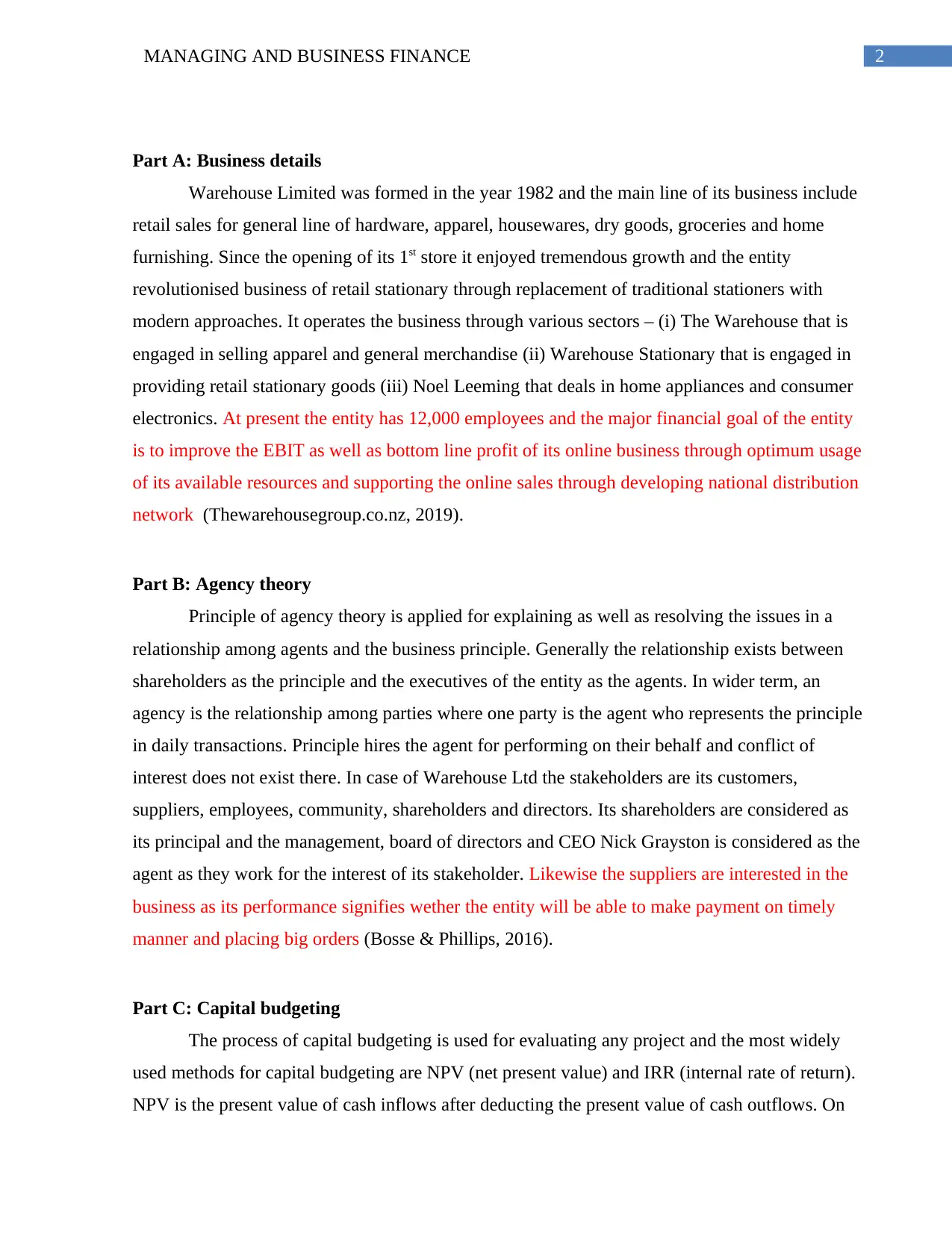
2MANAGING AND BUSINESS FINANCE
Part A: Business details
Warehouse Limited was formed in the year 1982 and the main line of its business include
retail sales for general line of hardware, apparel, housewares, dry goods, groceries and home
furnishing. Since the opening of its 1st store it enjoyed tremendous growth and the entity
revolutionised business of retail stationary through replacement of traditional stationers with
modern approaches. It operates the business through various sectors – (i) The Warehouse that is
engaged in selling apparel and general merchandise (ii) Warehouse Stationary that is engaged in
providing retail stationary goods (iii) Noel Leeming that deals in home appliances and consumer
electronics. At present the entity has 12,000 employees and the major financial goal of the entity
is to improve the EBIT as well as bottom line profit of its online business through optimum usage
of its available resources and supporting the online sales through developing national distribution
network (Thewarehousegroup.co.nz, 2019).
Part B: Agency theory
Principle of agency theory is applied for explaining as well as resolving the issues in a
relationship among agents and the business principle. Generally the relationship exists between
shareholders as the principle and the executives of the entity as the agents. In wider term, an
agency is the relationship among parties where one party is the agent who represents the principle
in daily transactions. Principle hires the agent for performing on their behalf and conflict of
interest does not exist there. In case of Warehouse Ltd the stakeholders are its customers,
suppliers, employees, community, shareholders and directors. Its shareholders are considered as
its principal and the management, board of directors and CEO Nick Grayston is considered as the
agent as they work for the interest of its stakeholder. Likewise the suppliers are interested in the
business as its performance signifies wether the entity will be able to make payment on timely
manner and placing big orders (Bosse & Phillips, 2016).
Part C: Capital budgeting
The process of capital budgeting is used for evaluating any project and the most widely
used methods for capital budgeting are NPV (net present value) and IRR (internal rate of return).
NPV is the present value of cash inflows after deducting the present value of cash outflows. On
Part A: Business details
Warehouse Limited was formed in the year 1982 and the main line of its business include
retail sales for general line of hardware, apparel, housewares, dry goods, groceries and home
furnishing. Since the opening of its 1st store it enjoyed tremendous growth and the entity
revolutionised business of retail stationary through replacement of traditional stationers with
modern approaches. It operates the business through various sectors – (i) The Warehouse that is
engaged in selling apparel and general merchandise (ii) Warehouse Stationary that is engaged in
providing retail stationary goods (iii) Noel Leeming that deals in home appliances and consumer
electronics. At present the entity has 12,000 employees and the major financial goal of the entity
is to improve the EBIT as well as bottom line profit of its online business through optimum usage
of its available resources and supporting the online sales through developing national distribution
network (Thewarehousegroup.co.nz, 2019).
Part B: Agency theory
Principle of agency theory is applied for explaining as well as resolving the issues in a
relationship among agents and the business principle. Generally the relationship exists between
shareholders as the principle and the executives of the entity as the agents. In wider term, an
agency is the relationship among parties where one party is the agent who represents the principle
in daily transactions. Principle hires the agent for performing on their behalf and conflict of
interest does not exist there. In case of Warehouse Ltd the stakeholders are its customers,
suppliers, employees, community, shareholders and directors. Its shareholders are considered as
its principal and the management, board of directors and CEO Nick Grayston is considered as the
agent as they work for the interest of its stakeholder. Likewise the suppliers are interested in the
business as its performance signifies wether the entity will be able to make payment on timely
manner and placing big orders (Bosse & Phillips, 2016).
Part C: Capital budgeting
The process of capital budgeting is used for evaluating any project and the most widely
used methods for capital budgeting are NPV (net present value) and IRR (internal rate of return).
NPV is the present value of cash inflows after deducting the present value of cash outflows. On
⊘ This is a preview!⊘
Do you want full access?
Subscribe today to unlock all pages.

Trusted by 1+ million students worldwide
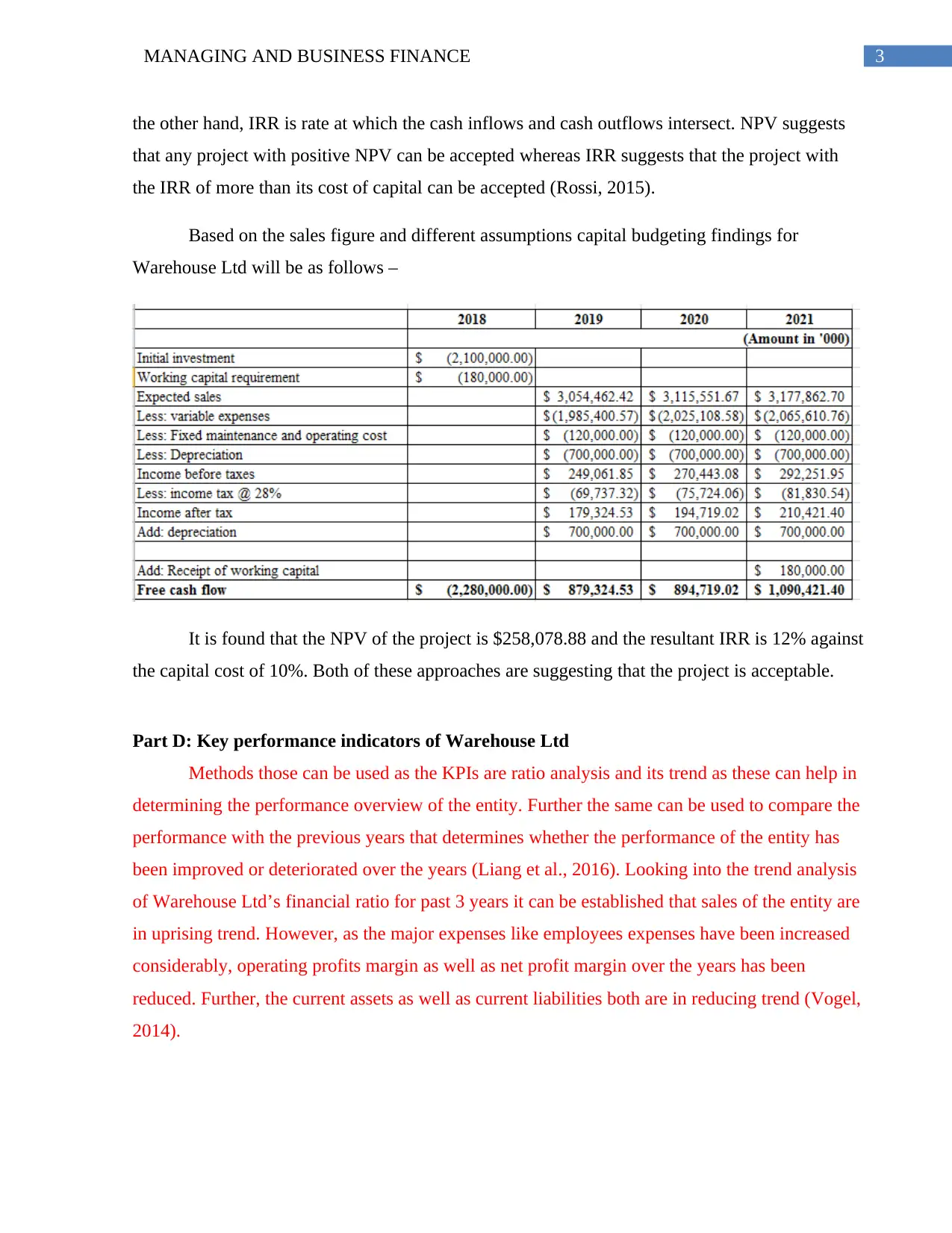
3MANAGING AND BUSINESS FINANCE
the other hand, IRR is rate at which the cash inflows and cash outflows intersect. NPV suggests
that any project with positive NPV can be accepted whereas IRR suggests that the project with
the IRR of more than its cost of capital can be accepted (Rossi, 2015).
Based on the sales figure and different assumptions capital budgeting findings for
Warehouse Ltd will be as follows –
It is found that the NPV of the project is $258,078.88 and the resultant IRR is 12% against
the capital cost of 10%. Both of these approaches are suggesting that the project is acceptable.
Part D: Key performance indicators of Warehouse Ltd
Methods those can be used as the KPIs are ratio analysis and its trend as these can help in
determining the performance overview of the entity. Further the same can be used to compare the
performance with the previous years that determines whether the performance of the entity has
been improved or deteriorated over the years (Liang et al., 2016). Looking into the trend analysis
of Warehouse Ltd’s financial ratio for past 3 years it can be established that sales of the entity are
in uprising trend. However, as the major expenses like employees expenses have been increased
considerably, operating profits margin as well as net profit margin over the years has been
reduced. Further, the current assets as well as current liabilities both are in reducing trend (Vogel,
2014).
the other hand, IRR is rate at which the cash inflows and cash outflows intersect. NPV suggests
that any project with positive NPV can be accepted whereas IRR suggests that the project with
the IRR of more than its cost of capital can be accepted (Rossi, 2015).
Based on the sales figure and different assumptions capital budgeting findings for
Warehouse Ltd will be as follows –
It is found that the NPV of the project is $258,078.88 and the resultant IRR is 12% against
the capital cost of 10%. Both of these approaches are suggesting that the project is acceptable.
Part D: Key performance indicators of Warehouse Ltd
Methods those can be used as the KPIs are ratio analysis and its trend as these can help in
determining the performance overview of the entity. Further the same can be used to compare the
performance with the previous years that determines whether the performance of the entity has
been improved or deteriorated over the years (Liang et al., 2016). Looking into the trend analysis
of Warehouse Ltd’s financial ratio for past 3 years it can be established that sales of the entity are
in uprising trend. However, as the major expenses like employees expenses have been increased
considerably, operating profits margin as well as net profit margin over the years has been
reduced. Further, the current assets as well as current liabilities both are in reducing trend (Vogel,
2014).
Paraphrase This Document
Need a fresh take? Get an instant paraphrase of this document with our AI Paraphraser
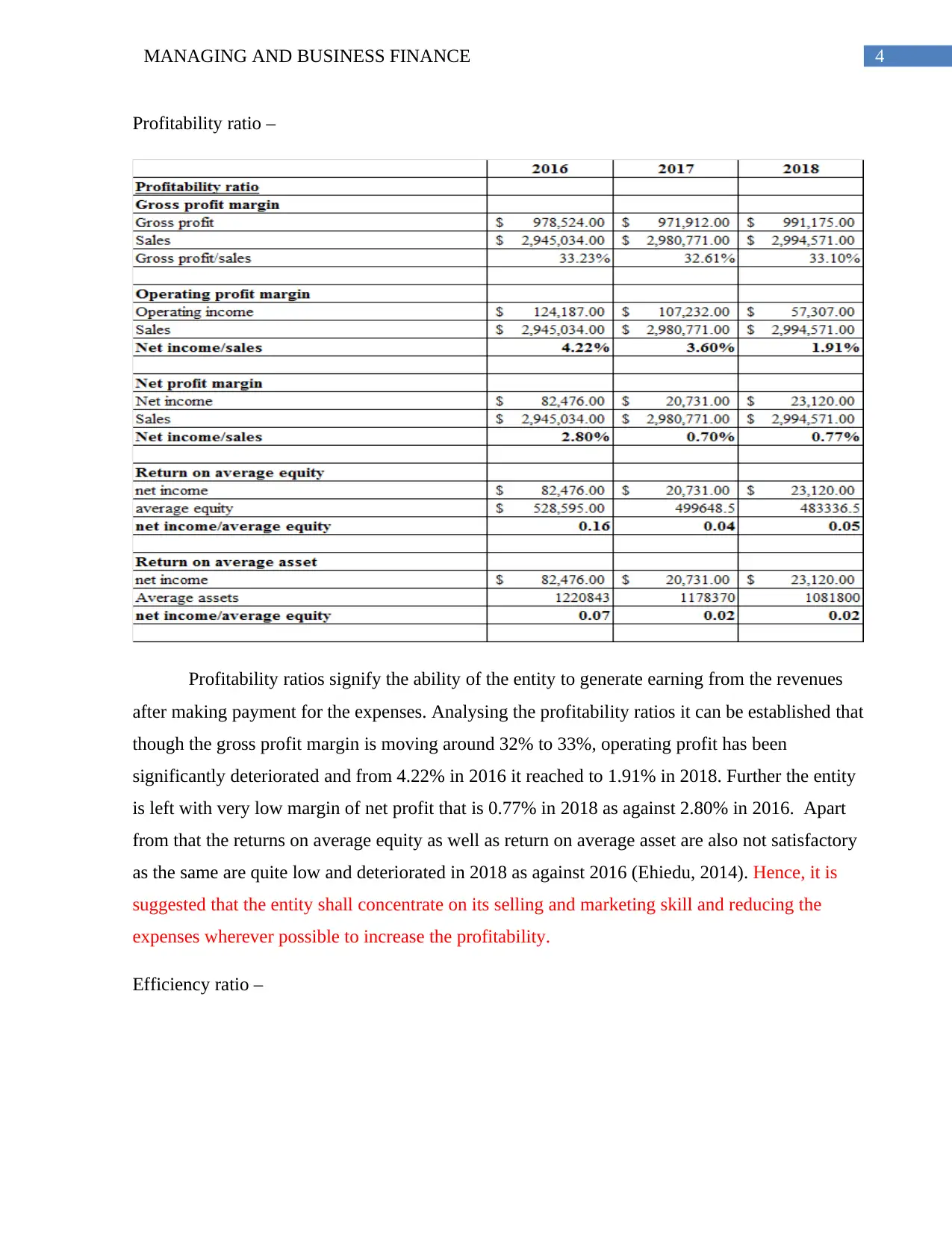
4MANAGING AND BUSINESS FINANCE
Profitability ratio –
Profitability ratios signify the ability of the entity to generate earning from the revenues
after making payment for the expenses. Analysing the profitability ratios it can be established that
though the gross profit margin is moving around 32% to 33%, operating profit has been
significantly deteriorated and from 4.22% in 2016 it reached to 1.91% in 2018. Further the entity
is left with very low margin of net profit that is 0.77% in 2018 as against 2.80% in 2016. Apart
from that the returns on average equity as well as return on average asset are also not satisfactory
as the same are quite low and deteriorated in 2018 as against 2016 (Ehiedu, 2014). Hence, it is
suggested that the entity shall concentrate on its selling and marketing skill and reducing the
expenses wherever possible to increase the profitability.
Efficiency ratio –
Profitability ratio –
Profitability ratios signify the ability of the entity to generate earning from the revenues
after making payment for the expenses. Analysing the profitability ratios it can be established that
though the gross profit margin is moving around 32% to 33%, operating profit has been
significantly deteriorated and from 4.22% in 2016 it reached to 1.91% in 2018. Further the entity
is left with very low margin of net profit that is 0.77% in 2018 as against 2.80% in 2016. Apart
from that the returns on average equity as well as return on average asset are also not satisfactory
as the same are quite low and deteriorated in 2018 as against 2016 (Ehiedu, 2014). Hence, it is
suggested that the entity shall concentrate on its selling and marketing skill and reducing the
expenses wherever possible to increase the profitability.
Efficiency ratio –
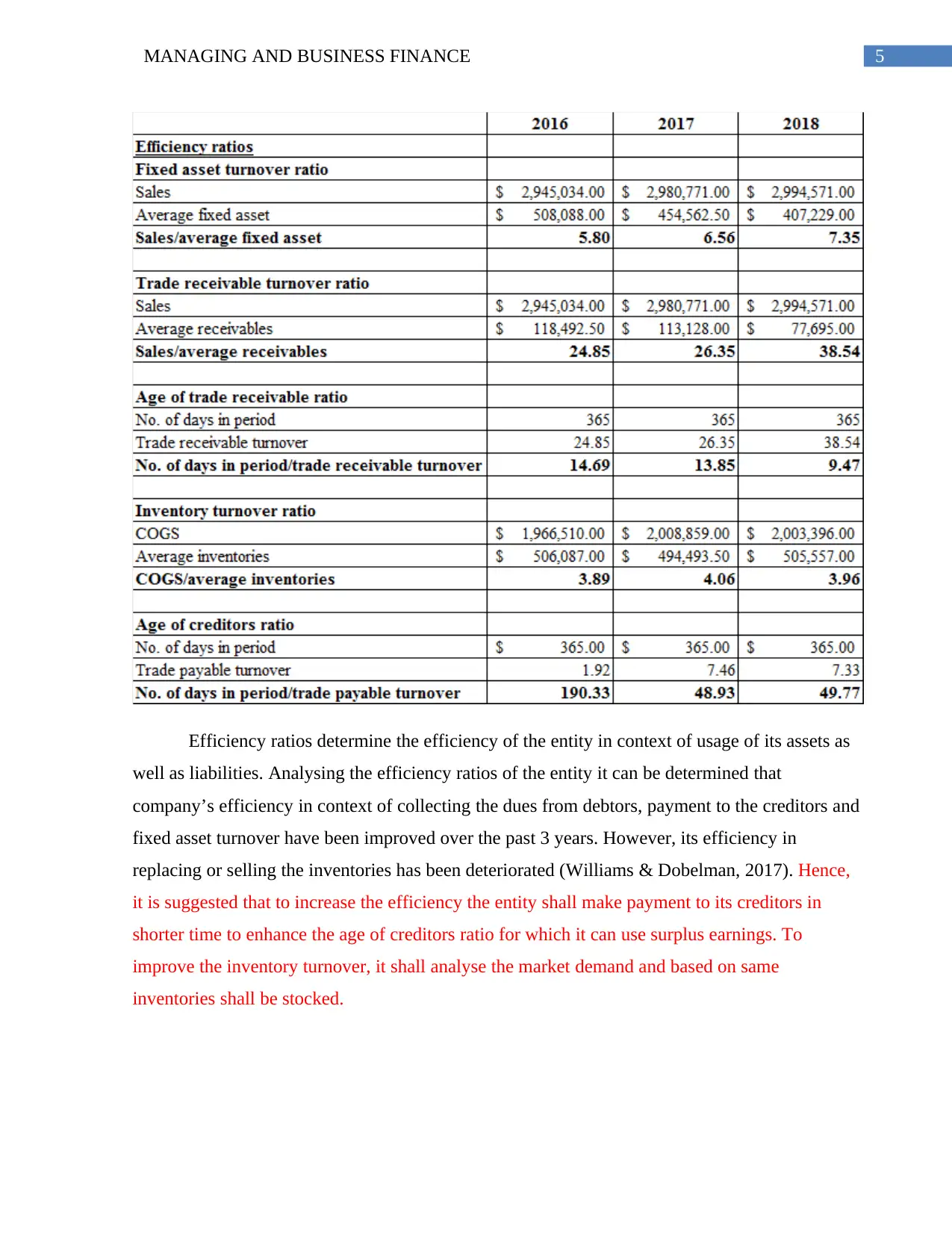
5MANAGING AND BUSINESS FINANCE
Efficiency ratios determine the efficiency of the entity in context of usage of its assets as
well as liabilities. Analysing the efficiency ratios of the entity it can be determined that
company’s efficiency in context of collecting the dues from debtors, payment to the creditors and
fixed asset turnover have been improved over the past 3 years. However, its efficiency in
replacing or selling the inventories has been deteriorated (Williams & Dobelman, 2017). Hence,
it is suggested that to increase the efficiency the entity shall make payment to its creditors in
shorter time to enhance the age of creditors ratio for which it can use surplus earnings. To
improve the inventory turnover, it shall analyse the market demand and based on same
inventories shall be stocked.
Efficiency ratios determine the efficiency of the entity in context of usage of its assets as
well as liabilities. Analysing the efficiency ratios of the entity it can be determined that
company’s efficiency in context of collecting the dues from debtors, payment to the creditors and
fixed asset turnover have been improved over the past 3 years. However, its efficiency in
replacing or selling the inventories has been deteriorated (Williams & Dobelman, 2017). Hence,
it is suggested that to increase the efficiency the entity shall make payment to its creditors in
shorter time to enhance the age of creditors ratio for which it can use surplus earnings. To
improve the inventory turnover, it shall analyse the market demand and based on same
inventories shall be stocked.
⊘ This is a preview!⊘
Do you want full access?
Subscribe today to unlock all pages.

Trusted by 1+ million students worldwide
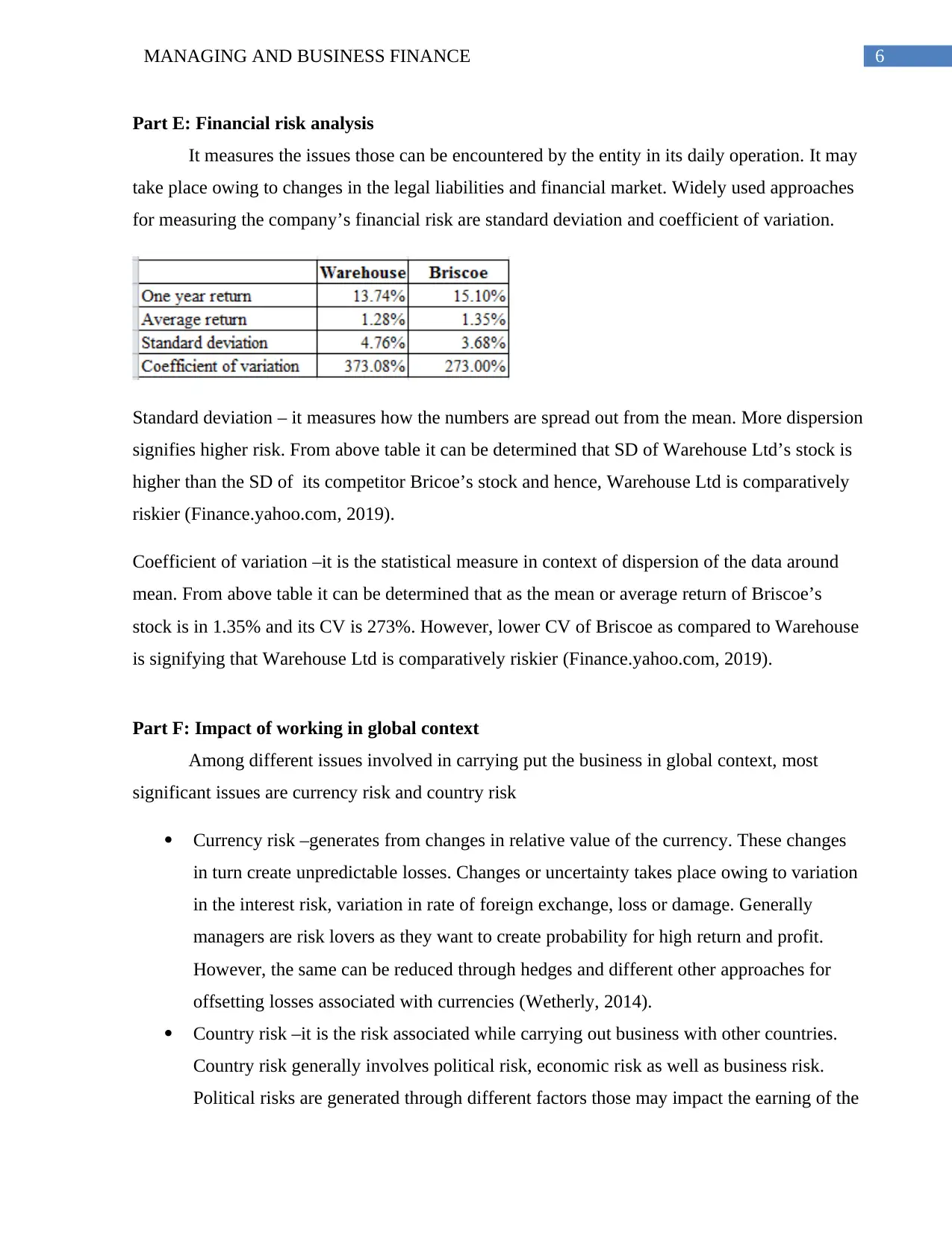
6MANAGING AND BUSINESS FINANCE
Part E: Financial risk analysis
It measures the issues those can be encountered by the entity in its daily operation. It may
take place owing to changes in the legal liabilities and financial market. Widely used approaches
for measuring the company’s financial risk are standard deviation and coefficient of variation.
Standard deviation – it measures how the numbers are spread out from the mean. More dispersion
signifies higher risk. From above table it can be determined that SD of Warehouse Ltd’s stock is
higher than the SD of its competitor Bricoe’s stock and hence, Warehouse Ltd is comparatively
riskier (Finance.yahoo.com, 2019).
Coefficient of variation –it is the statistical measure in context of dispersion of the data around
mean. From above table it can be determined that as the mean or average return of Briscoe’s
stock is in 1.35% and its CV is 273%. However, lower CV of Briscoe as compared to Warehouse
is signifying that Warehouse Ltd is comparatively riskier (Finance.yahoo.com, 2019).
Part F: Impact of working in global context
Among different issues involved in carrying put the business in global context, most
significant issues are currency risk and country risk
Currency risk –generates from changes in relative value of the currency. These changes
in turn create unpredictable losses. Changes or uncertainty takes place owing to variation
in the interest risk, variation in rate of foreign exchange, loss or damage. Generally
managers are risk lovers as they want to create probability for high return and profit.
However, the same can be reduced through hedges and different other approaches for
offsetting losses associated with currencies (Wetherly, 2014).
Country risk –it is the risk associated while carrying out business with other countries.
Country risk generally involves political risk, economic risk as well as business risk.
Political risks are generated through different factors those may impact the earning of the
Part E: Financial risk analysis
It measures the issues those can be encountered by the entity in its daily operation. It may
take place owing to changes in the legal liabilities and financial market. Widely used approaches
for measuring the company’s financial risk are standard deviation and coefficient of variation.
Standard deviation – it measures how the numbers are spread out from the mean. More dispersion
signifies higher risk. From above table it can be determined that SD of Warehouse Ltd’s stock is
higher than the SD of its competitor Bricoe’s stock and hence, Warehouse Ltd is comparatively
riskier (Finance.yahoo.com, 2019).
Coefficient of variation –it is the statistical measure in context of dispersion of the data around
mean. From above table it can be determined that as the mean or average return of Briscoe’s
stock is in 1.35% and its CV is 273%. However, lower CV of Briscoe as compared to Warehouse
is signifying that Warehouse Ltd is comparatively riskier (Finance.yahoo.com, 2019).
Part F: Impact of working in global context
Among different issues involved in carrying put the business in global context, most
significant issues are currency risk and country risk
Currency risk –generates from changes in relative value of the currency. These changes
in turn create unpredictable losses. Changes or uncertainty takes place owing to variation
in the interest risk, variation in rate of foreign exchange, loss or damage. Generally
managers are risk lovers as they want to create probability for high return and profit.
However, the same can be reduced through hedges and different other approaches for
offsetting losses associated with currencies (Wetherly, 2014).
Country risk –it is the risk associated while carrying out business with other countries.
Country risk generally involves political risk, economic risk as well as business risk.
Political risks are generated through different factors those may impact the earning of the
Paraphrase This Document
Need a fresh take? Get an instant paraphrase of this document with our AI Paraphraser
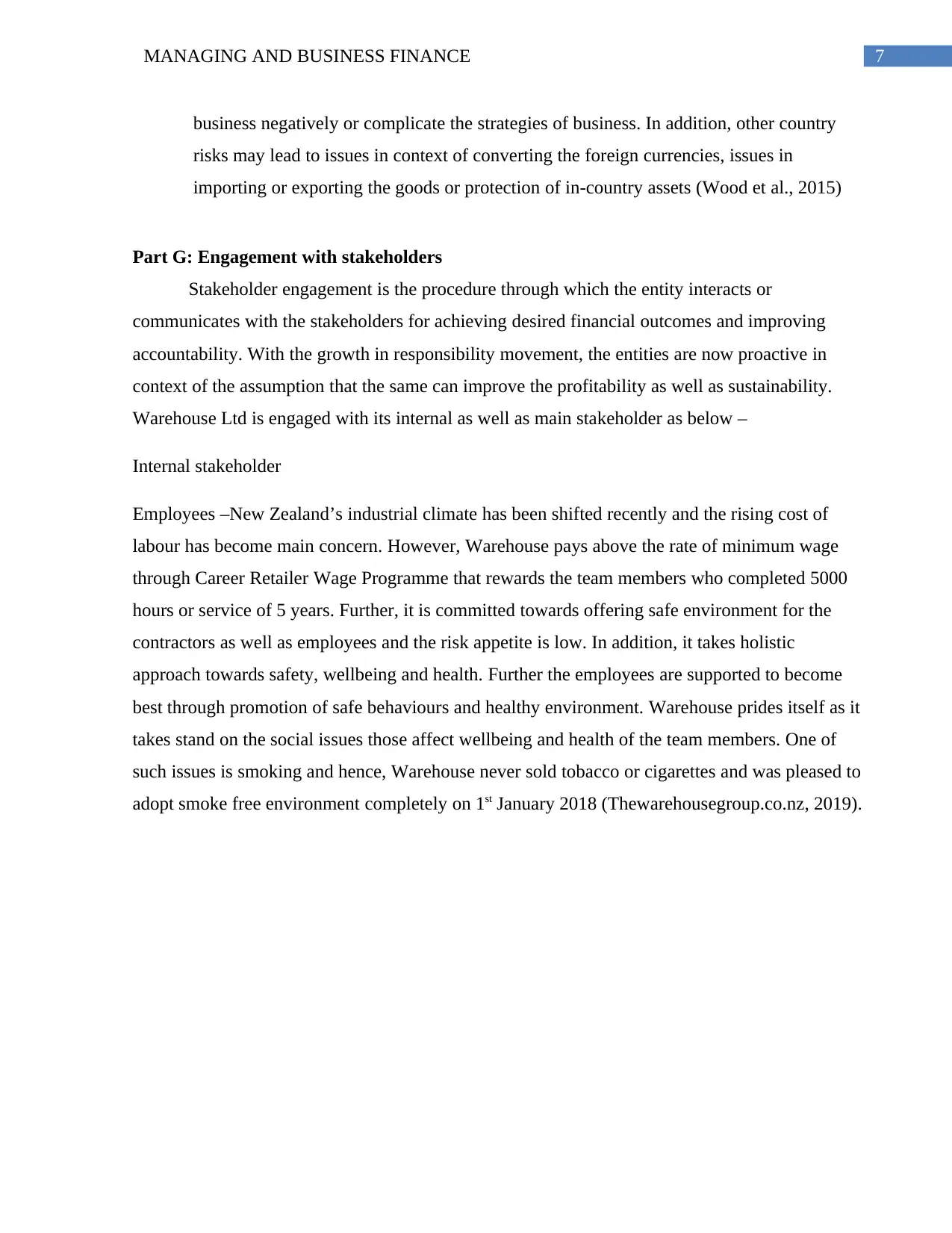
7MANAGING AND BUSINESS FINANCE
business negatively or complicate the strategies of business. In addition, other country
risks may lead to issues in context of converting the foreign currencies, issues in
importing or exporting the goods or protection of in-country assets (Wood et al., 2015)
Part G: Engagement with stakeholders
Stakeholder engagement is the procedure through which the entity interacts or
communicates with the stakeholders for achieving desired financial outcomes and improving
accountability. With the growth in responsibility movement, the entities are now proactive in
context of the assumption that the same can improve the profitability as well as sustainability.
Warehouse Ltd is engaged with its internal as well as main stakeholder as below –
Internal stakeholder
Employees –New Zealand’s industrial climate has been shifted recently and the rising cost of
labour has become main concern. However, Warehouse pays above the rate of minimum wage
through Career Retailer Wage Programme that rewards the team members who completed 5000
hours or service of 5 years. Further, it is committed towards offering safe environment for the
contractors as well as employees and the risk appetite is low. In addition, it takes holistic
approach towards safety, wellbeing and health. Further the employees are supported to become
best through promotion of safe behaviours and healthy environment. Warehouse prides itself as it
takes stand on the social issues those affect wellbeing and health of the team members. One of
such issues is smoking and hence, Warehouse never sold tobacco or cigarettes and was pleased to
adopt smoke free environment completely on 1st January 2018 (Thewarehousegroup.co.nz, 2019).
business negatively or complicate the strategies of business. In addition, other country
risks may lead to issues in context of converting the foreign currencies, issues in
importing or exporting the goods or protection of in-country assets (Wood et al., 2015)
Part G: Engagement with stakeholders
Stakeholder engagement is the procedure through which the entity interacts or
communicates with the stakeholders for achieving desired financial outcomes and improving
accountability. With the growth in responsibility movement, the entities are now proactive in
context of the assumption that the same can improve the profitability as well as sustainability.
Warehouse Ltd is engaged with its internal as well as main stakeholder as below –
Internal stakeholder
Employees –New Zealand’s industrial climate has been shifted recently and the rising cost of
labour has become main concern. However, Warehouse pays above the rate of minimum wage
through Career Retailer Wage Programme that rewards the team members who completed 5000
hours or service of 5 years. Further, it is committed towards offering safe environment for the
contractors as well as employees and the risk appetite is low. In addition, it takes holistic
approach towards safety, wellbeing and health. Further the employees are supported to become
best through promotion of safe behaviours and healthy environment. Warehouse prides itself as it
takes stand on the social issues those affect wellbeing and health of the team members. One of
such issues is smoking and hence, Warehouse never sold tobacco or cigarettes and was pleased to
adopt smoke free environment completely on 1st January 2018 (Thewarehousegroup.co.nz, 2019).
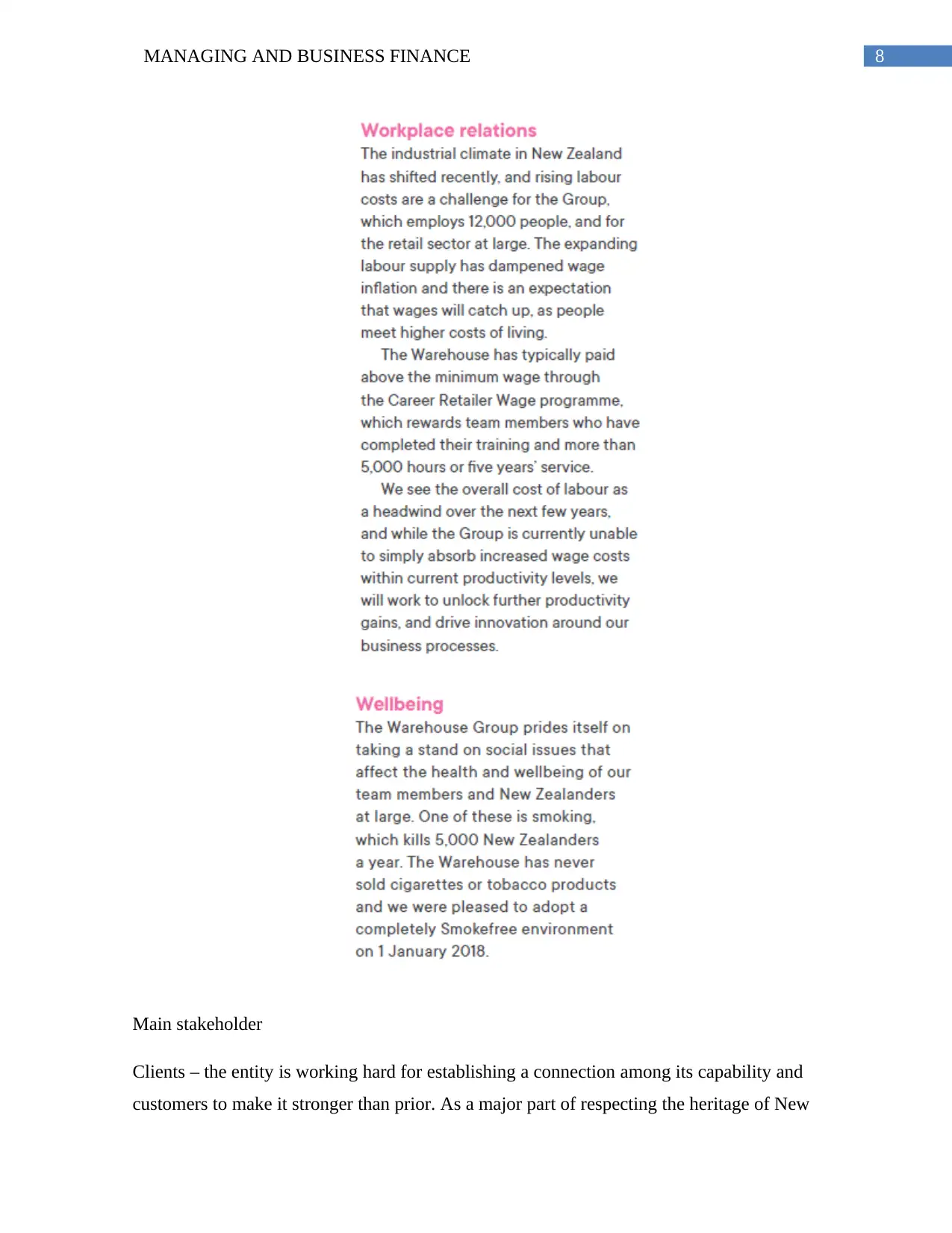
8MANAGING AND BUSINESS FINANCE
Main stakeholder
Clients – the entity is working hard for establishing a connection among its capability and
customers to make it stronger than prior. As a major part of respecting the heritage of New
Main stakeholder
Clients – the entity is working hard for establishing a connection among its capability and
customers to make it stronger than prior. As a major part of respecting the heritage of New
⊘ This is a preview!⊘
Do you want full access?
Subscribe today to unlock all pages.

Trusted by 1+ million students worldwide
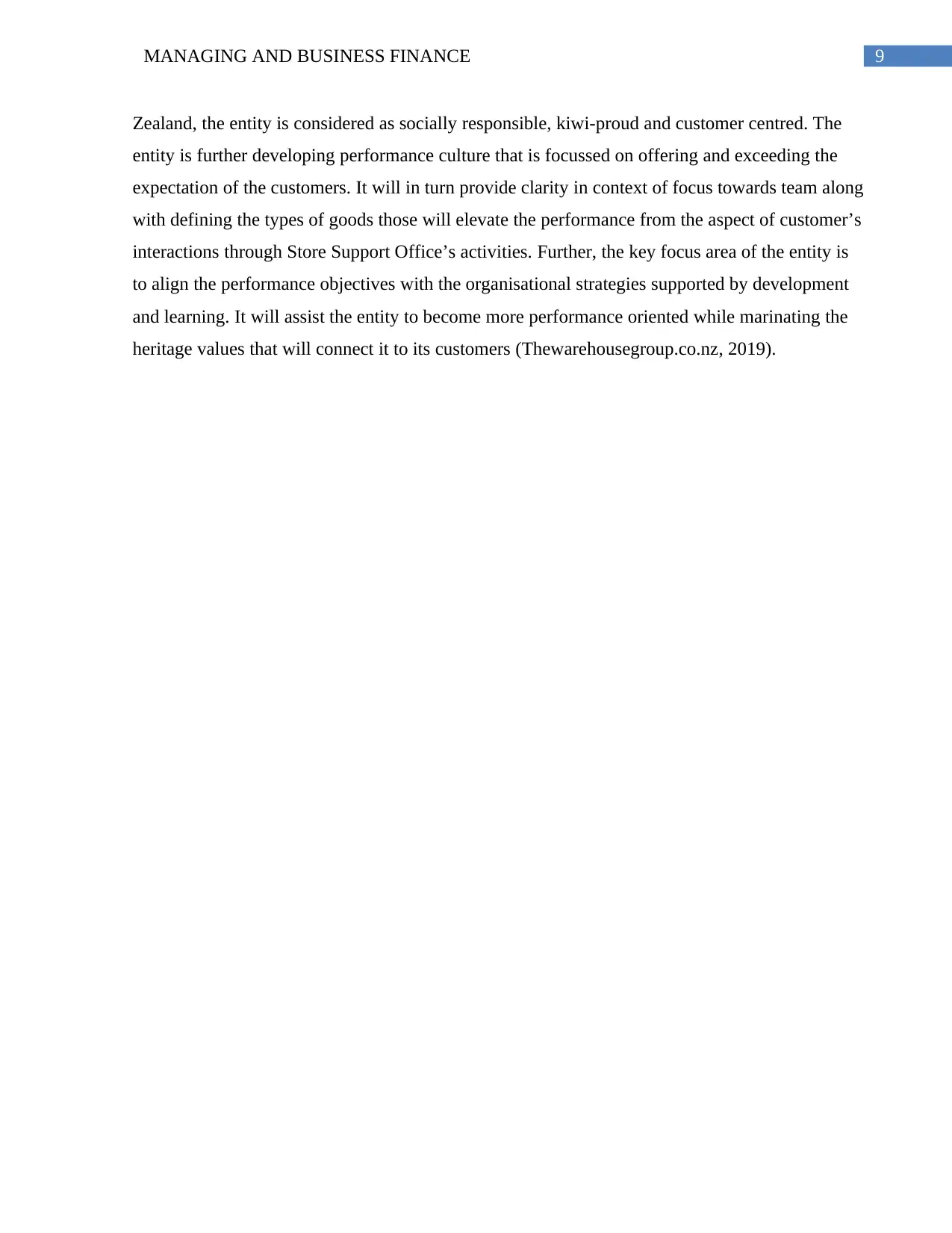
9MANAGING AND BUSINESS FINANCE
Zealand, the entity is considered as socially responsible, kiwi-proud and customer centred. The
entity is further developing performance culture that is focussed on offering and exceeding the
expectation of the customers. It will in turn provide clarity in context of focus towards team along
with defining the types of goods those will elevate the performance from the aspect of customer’s
interactions through Store Support Office’s activities. Further, the key focus area of the entity is
to align the performance objectives with the organisational strategies supported by development
and learning. It will assist the entity to become more performance oriented while marinating the
heritage values that will connect it to its customers (Thewarehousegroup.co.nz, 2019).
Zealand, the entity is considered as socially responsible, kiwi-proud and customer centred. The
entity is further developing performance culture that is focussed on offering and exceeding the
expectation of the customers. It will in turn provide clarity in context of focus towards team along
with defining the types of goods those will elevate the performance from the aspect of customer’s
interactions through Store Support Office’s activities. Further, the key focus area of the entity is
to align the performance objectives with the organisational strategies supported by development
and learning. It will assist the entity to become more performance oriented while marinating the
heritage values that will connect it to its customers (Thewarehousegroup.co.nz, 2019).
Paraphrase This Document
Need a fresh take? Get an instant paraphrase of this document with our AI Paraphraser
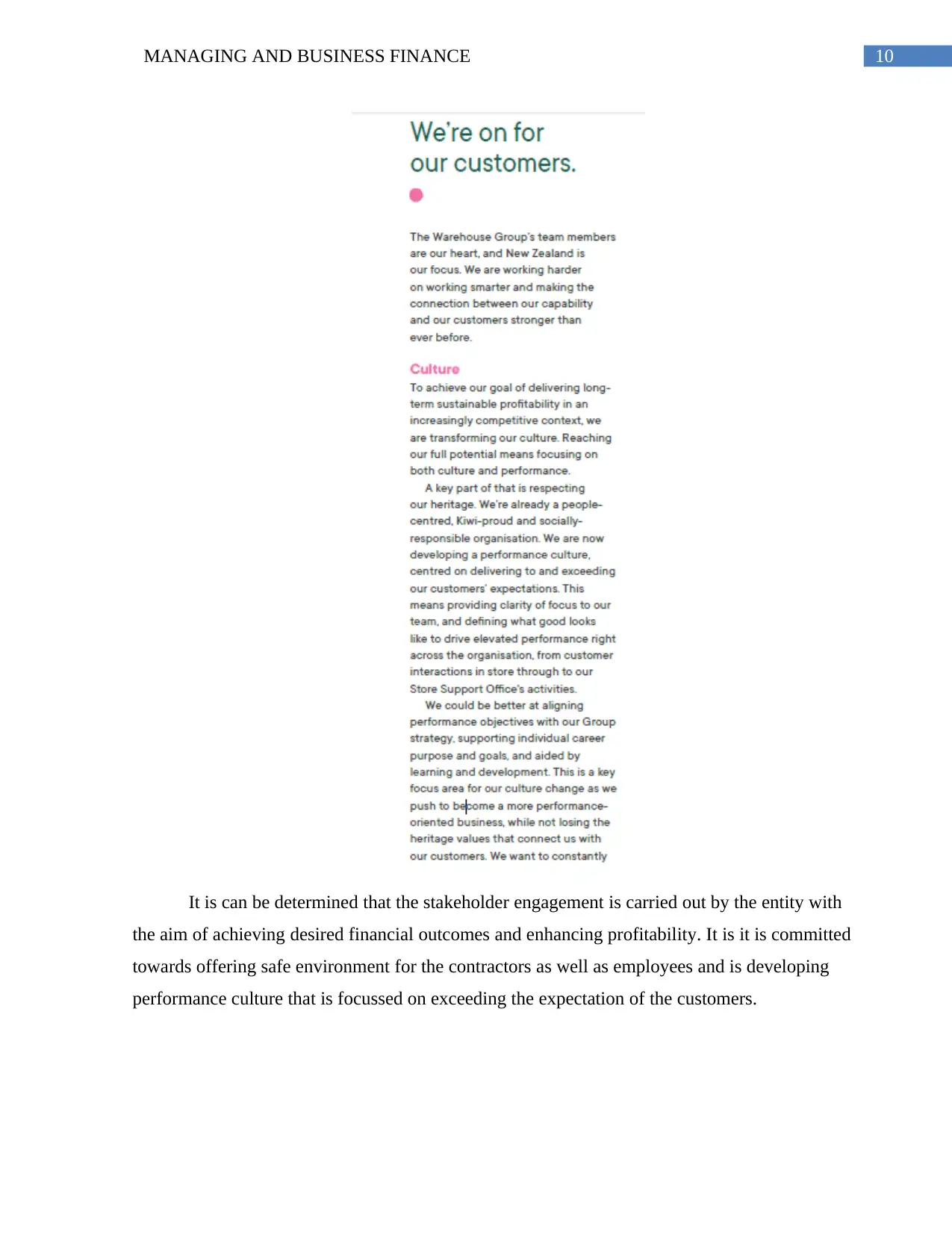
10MANAGING AND BUSINESS FINANCE
It is can be determined that the stakeholder engagement is carried out by the entity with
the aim of achieving desired financial outcomes and enhancing profitability. It is it is committed
towards offering safe environment for the contractors as well as employees and is developing
performance culture that is focussed on exceeding the expectation of the customers.
It is can be determined that the stakeholder engagement is carried out by the entity with
the aim of achieving desired financial outcomes and enhancing profitability. It is it is committed
towards offering safe environment for the contractors as well as employees and is developing
performance culture that is focussed on exceeding the expectation of the customers.
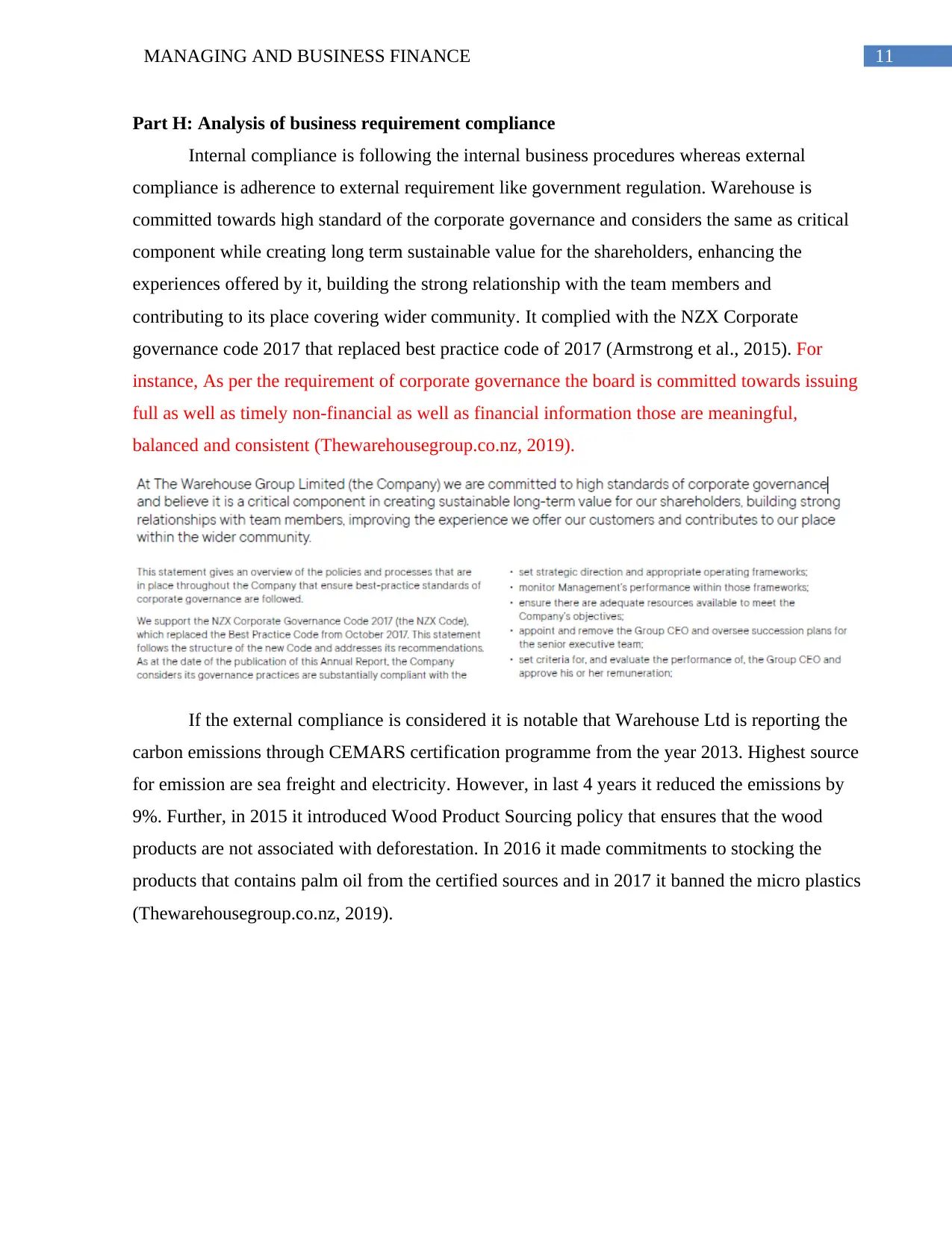
11MANAGING AND BUSINESS FINANCE
Part H: Analysis of business requirement compliance
Internal compliance is following the internal business procedures whereas external
compliance is adherence to external requirement like government regulation. Warehouse is
committed towards high standard of the corporate governance and considers the same as critical
component while creating long term sustainable value for the shareholders, enhancing the
experiences offered by it, building the strong relationship with the team members and
contributing to its place covering wider community. It complied with the NZX Corporate
governance code 2017 that replaced best practice code of 2017 (Armstrong et al., 2015). For
instance, As per the requirement of corporate governance the board is committed towards issuing
full as well as timely non-financial as well as financial information those are meaningful,
balanced and consistent (Thewarehousegroup.co.nz, 2019).
If the external compliance is considered it is notable that Warehouse Ltd is reporting the
carbon emissions through CEMARS certification programme from the year 2013. Highest source
for emission are sea freight and electricity. However, in last 4 years it reduced the emissions by
9%. Further, in 2015 it introduced Wood Product Sourcing policy that ensures that the wood
products are not associated with deforestation. In 2016 it made commitments to stocking the
products that contains palm oil from the certified sources and in 2017 it banned the micro plastics
(Thewarehousegroup.co.nz, 2019).
Part H: Analysis of business requirement compliance
Internal compliance is following the internal business procedures whereas external
compliance is adherence to external requirement like government regulation. Warehouse is
committed towards high standard of the corporate governance and considers the same as critical
component while creating long term sustainable value for the shareholders, enhancing the
experiences offered by it, building the strong relationship with the team members and
contributing to its place covering wider community. It complied with the NZX Corporate
governance code 2017 that replaced best practice code of 2017 (Armstrong et al., 2015). For
instance, As per the requirement of corporate governance the board is committed towards issuing
full as well as timely non-financial as well as financial information those are meaningful,
balanced and consistent (Thewarehousegroup.co.nz, 2019).
If the external compliance is considered it is notable that Warehouse Ltd is reporting the
carbon emissions through CEMARS certification programme from the year 2013. Highest source
for emission are sea freight and electricity. However, in last 4 years it reduced the emissions by
9%. Further, in 2015 it introduced Wood Product Sourcing policy that ensures that the wood
products are not associated with deforestation. In 2016 it made commitments to stocking the
products that contains palm oil from the certified sources and in 2017 it banned the micro plastics
(Thewarehousegroup.co.nz, 2019).
⊘ This is a preview!⊘
Do you want full access?
Subscribe today to unlock all pages.

Trusted by 1+ million students worldwide
1 out of 18
Related Documents
Your All-in-One AI-Powered Toolkit for Academic Success.
+13062052269
info@desklib.com
Available 24*7 on WhatsApp / Email
![[object Object]](/_next/static/media/star-bottom.7253800d.svg)
Unlock your academic potential
Copyright © 2020–2025 A2Z Services. All Rights Reserved. Developed and managed by ZUCOL.





